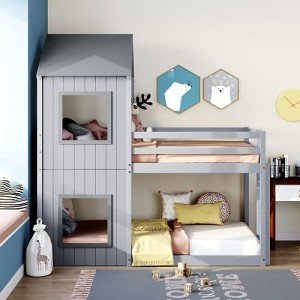Bunk beds have long been a popular option among moms and dads seeking to optimize space in their kids's bed rooms. With advantages that surpass their compact style, bunk beds offer a fun and functional sleeping plan while motivating sibling bonding and fostering imagination. In this comprehensive guide, we check out different elements of bunk beds for kids, including security considerations, different styles readily available, and recommendations for choosing the right one for your family.
Bunk beds are designed to stack one bed on top of another, making use of vertical space to develop more space for play and storage. They are especially useful for households with multiple kids or minimal bed room space. In addition, they offer an adventurous sleeping environment that children frequently enjoy.
When selecting a bunk bed for kids, security must be the leading priority. The following features are crucial for making sure a safe sleeping environment:

Bunk beds are available in a variety of styles, permitting moms and dads to select one that matches their child's room decor while meeting particular requirements. Below are some popular designs:
| Bunk Bed Style | Description | Best For |
|---|---|---|
| Standard | Classic style with two stacked beds | Requirement bedroom setups |
| Loft Bed | Raised bed with functional space underneath | Homework or play locations |
| L-Shaped | Bunk beds organized in an L-shape | Corner areas |
| Twin over Full | Twin bed on top, complete bed below | Various age brother or sisters |
| Triple Bunk | Three stacked beds | Large households or sleepovers |
When searching for the perfect bunk bed, think about the following elements to ensure you make an informed decision:
Typically, children aged 6 and older must be able to securely sleep in the leading bunk, though you must always consider your child's maturity level.
It is not a good idea for toddlers or really children to sleep in the top bunk due to the danger of falling.
Check the bed frequently for any signs of wear and tear, tightening up screws, and cleaning up the bed mattress to guarantee extended security and sturdiness.
Many bunk beds are created to be convertible, allowing you to separate the beds when required. Examine the manufacturer's requirements before acquiring.
Utilize under-bed drawers, racks, or lofted designs to create additional storage services in a space with a bunk bed.
Bunk beds use a delightful blend of fun, functionality, and space-saving utility, making them an ideal choice for young households. By considering safety features, numerous designs, and useful factors such as space size and age suitability, moms and dads can pick the perfect bunk bed for their kid's requirements. With the right option, bunk beds can transform a bedroom into a magical space that encourages play, creativity, and bonding amongst siblings. Always keep in mind to prioritize security and upkeep to maximize this unique sleeping plan.
No Data Found!

